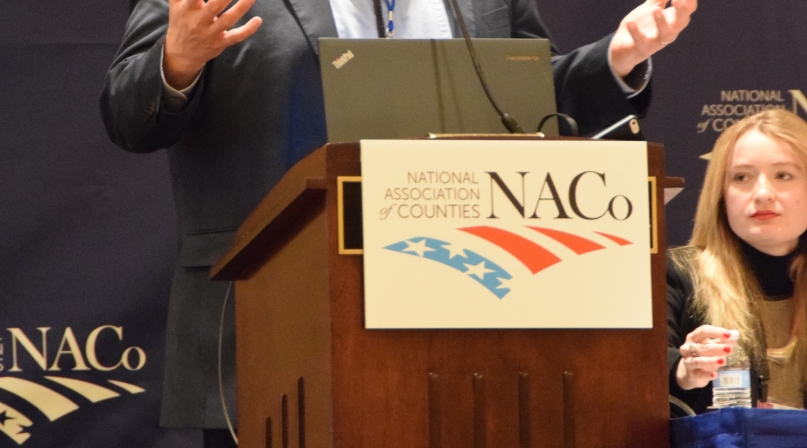Counties accept challenge to combat rural poverty
Upcoming Events
Related News

Dr. Donald Warne discusses some of the unique poverty issues faced by Native-American children and families. Photo by Leon Lawrence IIIFirst 13 counties accept challenge to prioritize reducing rural child poverty
U.S. Secretary of Agriculture Tom Vilsack laid down the gauntlet at NACo’s 2016 Legislative Conference by asking counties nationwide to commit to reducing rural childhood poverty.
He announced the Rural Impact County Challenge at the White House Rural Council’s Poverty Summit, Feb. 23, held in conjunction with the conference.
The challenge asks at least 100 counties pass resolutions by this summer that prioritize reducing rural child poverty — and to develop new, or fine tune existing, “actionable plans” to address the needs of rural children and families.
At the summit, 13 counties signed pledges to accept the challenge.
“County officials have an extraordinary opportunity, and I think responsibility, to provide leadership,” Vilsack said. “You can help us tailor our programs, use them in a very focused and coordinated way to have a profound impact.”
Jessica Carson, a researcher with the University of New Hampshire’s Carsey School of Public Policy, framed the issue of childhood poverty with data the Carsey School had released that very day.
In 1980, 36 percent of counties had at least 20 percent of children in poverty. However, by 2010 that number had grown to 58 percent, she said. Rural counties consistently have a much higher incidence of child poverty than urban counties. In 2010, approximately two-thirds of rural counties had high child poverty compared to about half of urban counties, she added.
The summit, titled Opportunity for All: Building a Brighter Future for Rural Families, featured two panels: Rural Poverty: Prevalence and Implications for Child Well-being, and Evidence-based and Promising Practices for Addressing Rural Childhood Poverty.
Dr. Bernard Dreyer, president of the American Academy of Pediatrics, was among the panelists for the first session, and he likened child poverty to a “significant non-communicable disease.”
“Poverty can’t be seen on an x-ray; poverty can’t be heard through a stethoscope, and yet pediatricians have an important role to play in identifying poverty, in the examining room, just like we diagnose an ear infection or asthma,” he said.
Childhood poverty can have a “profound negative” effect on infant mortality, immunization rates, nutrition, language and social-emotional development, he added. “What’s more, the effects can lead to toxic stress that alters the way young children’s brains develop.” Some examples of toxic stress are intense or prolonged exposure to adversity, such as family violence, emotional abuse or a caregiver’s drug abuse.
“This leads to lower educational attainment, higher crime rates, teen pregnancy and drug and alcohol abuse, all of which make it hard for those who are born into poverty to break the cycle.”
He added that childhood poverty costs the U.S. economy more than $500 billion per year in lost productivity.
The summit’s second panel highlighted effective steps that are being taken to reduce child poverty, many of which have to do with good nutrition and early childhood education.
Audrey Rowe, administrator of USDA’s Food and Nutrition Service, said opportunities exist to vastly improve rural children’s access to nutritious foods. Thirty-one percent of rural grade school children receive free and reduced price meals, she said, but 43 percent of families who meet income eligibility guidelines don’t participate in any child rural poverty nutrition programs.
One program that’s reaching more children is the Community Eligibility Program under the Healthy Hunger-free Kids Act.
“This allows children to participate in our school meals program so that if the school is in an area that is high poverty, all of the children in that school are able to receive a school lunch or a school breakfast,” Rowe said, adding that this helps remove any stigma that might discourage participation in a “free” program.
As did other speakers, Anne Mosle, vice president and executive director of the Aspen Institute’s Ascend program, touted the potential of “two-generation” solutions to alleviating persistent poverty.
“A two-generation approach,” she explained, “is simply children and their parents — or adult in their life — moving forward together, through education, economic support, workforce development and good employment.”
Ascend identifies promising practices from early childhood education centers to postsecondary institutions, and from community organizations to social capital-building programs.
If a child’s parents and the family are not secure, not heathy, not educated, there’s no way that child will be, Mosle said. The approach promises both upstream and downstream benefits.
“And when that child starts to succeed to read, to excel, the motivating impact that has on the family is powerful.”
More Legislative Conference coverage
- Legislative Conference packed with insights, innovations and influence
- Steering committees explore new legislative policy
- Speakers assess trends in political climate
- Governors’ Roundtable discussion tackles persistent rural poverty
- Workshop: Keeping Counties Moving: Understanding the Role of Freight Transportation as an Economic Engine
- County leaders take criminal justice reform plans to Capitol Hill
- Legislative Conference Workshop: Counties on the Frontlines: The Escalating Substance Abuse Epidemic
- New group forms for LGBT leaders, allies
Attachments
Related News

Counties and Railroads: Shared Priorities for the Next Surface Transportation Bill
County leaders from across the country have a vital opportunity to ensure their infrastructure priorities are front and center.

House reintroduces bipartisan legislation to level playing field for rural communities
House reintroduced the Rural Partnership and Prosperity Act, bipartisan legislation intended to advance economic development in rural counties and overcome barriers to obtaining federal funding and resources.

Podcast: Eastern Tennessee counties invest in tourism during shutdown
Sevier County, Tenn. refused to let the government shutdown devastate its fall tourism draw—Great Smoky Mountains National Park. County Mayor Larry Waters describes the lengths he and his neighbors went to keep the park open. And NACo Chief Government Affairs Officer Mark Ritacco offers an outlook on what counties can take away from the shutdown and into the future.